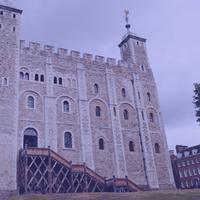Episode 280: The Tower of London [2]
The tradition of keeping ravens at the Tower of London
dates back to the time of Charles II in the 17th century.
While there had been ravens earlier, Charles II was the first monarch to insist
that they were protected, appointing a Yeoman Warder Ravenmaster to care for them.
Legend has it that there must always be a minimum of six ravens at the
Tower or else the Tower and the monarchy will fall, it will collapse.
Naturally, it's not a good idea to leave the fate of the Tower of London or the monarchy
completely up to the ravens, so their feathers are cut so they can't fly to far.
As a little fun linguistic aside, the collective noun for a group of ravens is an unkindness or
a conspiracy - it's probably linked to ravens often being considered to be unlucky or creepy.
Now, just to conclude this episode, I wanted to share some other interesting facts about what else
The Tower of London was used for, facts you might not hear on a tour, or read about in a guide book.
From the 1200s to 1835, the Tower of London also housed what was known
as the Royal Menagerie, essentially a zoo containing exotic animals.
The Tower of London was at one point home to a polar bear, a gift
from the King of Norway, an elephant, from the King of France and
three lions, or possibly leopards, gifted by the Holy Roman Emperor.
Over the years, the collection grew to include a tiger, jackals, leopards and eagles.
However, over time people became more aware of the unsuitability of
the surrounding for animals, and the Menagerie closed down in 1835.
What happened to the animals, you might be asking?
Well, 150 animals were rehoused to Regent's Park in 1826, creating what would become
London Zoo, an actual, purpose-built real zoo, not a prison-come-castle turned into a zoo.
And although exotic animals are precious and valuable, they weren't the
most valuable things kept under lock and key at The Tower of London.
Weapons and armour were stored there, of course.
But, being such a secure place, the Tower of London was the ideal
place to control England's currency supply, the supply of money.
All English coins were created, or “minted”, at the Tower of London from
the end of the 13th century up until 1810 in what was called the Tower Mint.
And of course, if you go to The Tower of London today, you too can see
debatably the most valuable piece of jewellery in the country, The Crown
Jewels, which are thought to be worth anywhere from 4 to 6 billion Euros.
And who is responsible for guarding them?
The Beefeaters of course.
And our final curiosity about The Tower of London is that the first person to be kept
prisoner in The Tower of London was also the first person to escape from the Tower of London.
His name was Bishop Ranulf Flambard, and he was thrown into the Tower of London
after falling out of favour with William the Conqueror's younger brother, Henry I.
Henry I threw the bishop into the tower, but it sounded
like it wasn't a particularly uncomfortable prison.
The bishop still had access to money and fine food.
He decided to put on a banquet, a large meal, for his jailors,
and ordered for barrels of wine to be sent into the Tower.
In one of these barrels was a rope, and while the guards were enjoying
the fine food and wine, perhaps enjoying the wine too much, the
bishop used this rope to lower himself out of the Tower to safety.
His supporters had arranged for a horse to be left outside the window.
The bishop jumped onto it, rode all the way to the coast and then got on a boat to France.
So, there you go, a brief history of The Tower of London.
From its beginnings as a defensive castle, a royal residence, prison, mint, zoo and home to the
Crown Jewels, the Tower of London has a rich and fascinating history, spanning over 900 years.
It's little wonder that the once feared Tower of London is now one of the most popular UK
tourist attractions, as well as a national monument that is a central part of English history.
And it's one that you can still visit today, and I'd certainly recommend you do.
Go to The Tower, strike up a conversation with a Beefeater, think of all the
prisoners who spent their last days looking out through the prison windows.
And keep a lookout for ravens.
If you can't see six of them, well, you might just be the first person
to realise that the future isn't bright for the British monarchy.
OK then, that is it for today's episode on the Tower of London.
I hope it's been an interesting one, and you've learned about the real
history of London's most iconic landmark, as well as some of the quirky
details that you're less likely to hear about on the tourist trail.
As always, I would love to know what you thought about this episode.
Have you ever been to the Tower of London or are you planning to?
If you've been, did you see the Beefeaters, or even the Crown Jewels?
I would love to know, so let's get this discussion started.
You can head right into our community forum, which is at
community.leonardoenglish.com and get chatting away to other curious minds.
You've been listening to English Learning for Curious Minds, by Leonardo English.
I'm Alastair Budge, you stay safe, and I'll catch you in the next episode.

